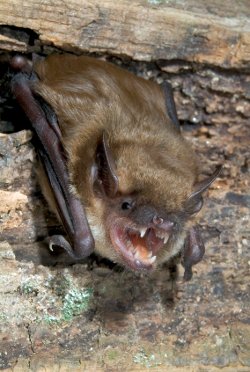|
Big Brown Bats (Eptesicus fuscus) If you take a look at big brown bats, one of the first things you'll probably notice are their impressive teeth. They're pretty big and just what they need to eat one of their favourite prey, beetles. They also eat other insects like spiders, moths and even wasps! They grow to between 10 to 12 cm in length (4 to 5 inches) and have a wingspan of up to 32.5 cm (13 inches). Compared to other insect-eating bats like the Common Pipistrelle, which can fit into a match box, that's pretty big. However, they only weigh around 14 to 17 g (1/2 to 5/8 oz). One surprising thing about them is that unlike most other echolocating bats, they make noises that we can hear when they're flying. These nocturnal, shiny brown mammals are the most common bat in North America. And their range extends from central Canada to northern Mexico. During the winter months, when insects are hard to come by, big brown bats hibernate. Caves and mines, were temperatures remain stable are their preferred winter roosting sites. But if the winter's mild, they might also hibernate under house eaves. Sometimes, if the temperature gets a bit warmer, they'll wake up to have a drink and to breed. By March, they come out of hibernation and in early June, the female bats start to have their babies (called pups). They set up maternity roosts which can sometimes have over a hundred bats. Males are welcome to roost in them too but sometimes, they roost alone. Each pregnant bat will have one to two pups and after nine weeks, they're ready to fly and catch their own insects In the summer time, roost sites include hollows in trees, buildings and bridges. Big brown bats have adapted very well to the human environment. This is a double-edged sword for them as it means they're spoilt for choice in terms of roost sites. But it also means that they're the bat species that people are most likely to encounter. Due to the fear many people have of bats, these encounters can sometimes end unhappily. But it doesn't have to be this way. People and bats can live in the same building without their being any danger to either party. And
bat removal
can be harmless and humane. Return from Big Brown Bats to Chiroptera - the order of bats
|







